For this episode of Lasang Pinoy I was honored to be invited by Kai to participate in the 24th episode. Unfortunately, I didn’t get the invitation early enough due to a send-mail issue with my web server. Having said that, I have to use my previous recipe blog that I wrote several months ago. Even though it is not the latest entry of my blogs it still fits the theme of Coconut, not to mention this dish is very popular and highly searched for on the internet. The Coconut is truly a wonder tree. Coconut trees are the only tree I know in the world that you can use everything from the fruit, or more likely the nut, all the way down to its trunk. The nut is used in a variety of food products from Coconut creme, milk, meat, and juice.
The leaves can be used as Brooms (walis tingting), Nepa hut siding, snack wrapping (suman), or you can weave it and make a square ball out of it. I remember my cousin’s and I used to make these square balls and play with them all day long.

And of course the Coconut trunk can be used for cheap lumber, most commonly used in the Philippines to make concrete forms and also used to build huts as an alternative for more types of traditional lumber. Okay enough said, now let see my recipe!
Is it hot in here? No, not yet! But it will be as we dig deeper into this particular dish. First things first, before we get any deeper into this recipe I just want to make certain things clear. I’m not a Bicolano nor have I ever even been in Bicol. I was born in Antipolo Rizal and basically grew up in Quezon City before moving here to the U.S. in September of 1992. I’m going to apologize in advance if any of my facts aren’t totally accurate.
Ok, let’s continue! Bicolano’s have been well known for their fiery obsession for centuries. They often use scalding-hot peppers as a main ingredient in most if not all of their vegetable dishes especially in the first district of Albay. Bicol Express is a very popular dish originated from Bicol, but oddly enough in Bicol from what I read, they don’t even call it Bicol Express. So the dish itself did originate from Bicol, but not the name.
They say that this dish evolved from another dish called gulay na may lada. I also read that the reason they call this Bicol Express is that it makes you run for water like an express train as soon as you put it in your mouth. Whether this is how they got the name or not, I don’t know.
What I can tell you for sure is that this stuff is very good and thanks to the Bicolano’s for coming up with it. Bicol Express nowadays has so many variations that just about everyone that has cooked this dish had modified it to their own personal preference.
They have to accommodate their level of obsession when it comes to scalding-hot peppers. I have looked at several recipes online about Bicol Express before coming up with my own recipe. Even though this is not the authentic Bicol Express, it’s still very good and it will not put you in a coma, but in order for me to use the original name it does have to have a certain degree of hotness.
My version of Bicol Express does not use scalding-hot peppers as a main ingredient, instead I used it as a secondary ingredient. I love hot peppers, but unfortunately my obsession with hot peppers does not quite measure up to the Bicolano’s, so mine is a milder version. Now let’s take a look at the recipe!
Ingredients:
- 1 ½ Lbs. Pork belly cut in 1 in. cubes
- 1 Lb. Calabaza cut in 1 ½ in. cubes
- 1 Large ginger peeled & sliced thinly
- 2 Cans of Coconut milk 13.5 oz each
- 1 Large onion diced
- 4 Cloves of garlic peeled & smashed
- 1 Tsp. Ground black pepper
- ½ Tsp. MSG – optional
- 36 Pcs. Thai-peppers, stems removed
- 6 Finger peppers Siling mahaba cut in ¼ in. pieces, discard stems
- Corn oil for sauteing
- Green Onions for garnish
Note: Thai, Birds Eye, and Siling Labuyo are the same
Directions:
- In a large pot heat 1 Tbs. of corn oil and saute garlic until golden brown.
- Next add pork belly, season it with salt, and saute it for 3 minutes on medium heat.
- Add onions and ginger root and let it cook for 2 minutes.
- Add coconut milk, ground black pepper, msg, finger peppers, and Thai-peppers.
- Stir well and let it simmer for 25 minutes on medium low heat, stirring occasionally to avoid scorching.
- Then add calabaza and let it cook for ten minutes or until calabaza is tender.
- Adjust taste by adding salt & pepper if needed! Serve rice topped with Bicol Express & garnish with green onions.
- Enjoy & Feel the Heat!..
Note:
On this particular recipe I have my ginger root sliced in larger pieces so I can remove them before serving. However if you want to serve yours with ginger root you may do so by slicing it in smaller pieces (julliene).
My final thoughts:
This is truly a magnificent dish. One piece of advice though is to only use as many chili peppers as you can handle. You can gradually increase the amount of chili peppers later on as you get used to the heat. As they say eating is one of life’s pleasures, taste and flavor are just as important to make sure you enjoy the food. That is why it is important that you do not exceed your own limit with chili peppers. You want to enjoy your food and not put yourself in severe pain.
When eating Bicol Express with the right amount of hotness to your liking you can truly enjoy this wonderful dish. You will immediately feel the heat as soon as you introduce it to your taste buds. The capsaicin from the chili peppers will trigger your brain to release endorphins which are a natural pain killer the human body produces. That’s when you get to the zone of enjoying one of life’s pleasure. Eating!…
For those of you who really like it insanely hot, there are chili peppers out there that are so hot they could be used as a weapon. The mighty Trinidad Scorpion Peppers!
For more information about Chili Peppers Click Here!
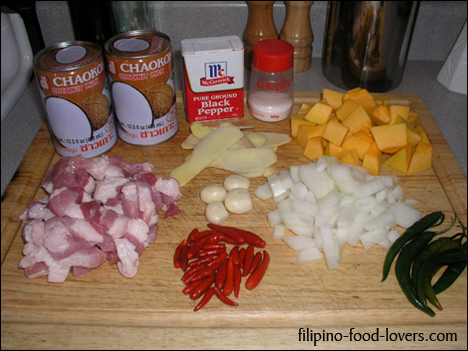
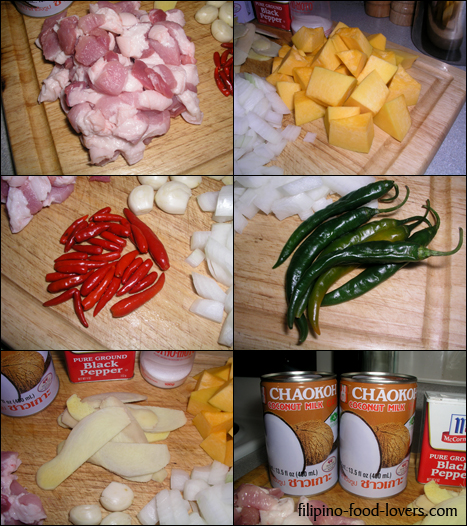
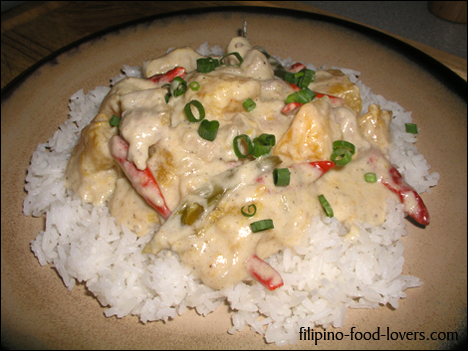
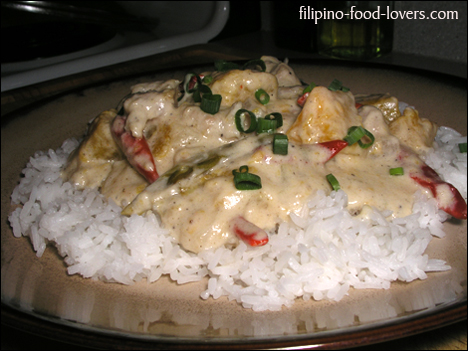
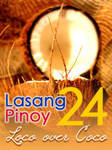
 Posted in
Posted in  Tags:
Tags: 


Indeed, there are so many stories about the origin of Bicol Express that it makes for a very interesting read. I love your recipe version because of the squash component – pork and squash in gata, separately or together, are divine.
The fire in this dish makes for huge consumption of rice. Mmmmm!
Thanks for a great LP entry!
another bicol express to make my mouth water! aaaaahhhh… wish they’d have hefty servings at the cafeteria of this… i like mine just mildy hot. nothing like spicy food to make you keep digging into kanin. 😀 haha
Bursky,
Coconut and hot peppers goes together perfectly.. It is truly an appetite booster.. 🙂
-Robert
my japanese hubby loves your recipe thanks a lot. ang dami nyang nakain.
This is a great recipe, and the pictures help so much. I’m planning on making this dish for a potluck dinner coming up, how many servings does this recipe make? Any suggestions when making in large amounts?
Alan,
This recipe is about 4-6 servings, it just defends on how much tolerance you have on hot peppers. If you want to cook more just double the recipe, that should be enough for your potluck. Good luck!
-Robert
I love this site. actually I am marinating the Pork BBQ for my tomorrow’s Birthday party I can’t wait to try it. I am definitely trying to cook the Bicol Express that sounds yummy plus the fact I love anything spicy extra spicy. Thank’s for creating this helpful site Keep up the good work!
I love this site! I am not Filipino, but work with a lot of people from the Philipines and have grown to love the food (I’ve even tried Balut). The only way I have been able to satisfy my craving for Filipino food is through potlucks at work, but thanks to you, I can now cook my own. I’m going to surpirse everyone at the next potluck and prepare one of your dishes! Thanks and keep up the good work!
I had a friend who like me, had spent some time in the P.I. while in the Navy. His Lynda wife was from Manila. They opened a Filipino restaurant here in the states, in a town that unfortunately lacked appreciation for it. Eventually it closed and they moved on. He used to make the most awesome hot wings, I always ordered them with my pancit. They were fried and then tossed in a sauce, like buffalo wings, but the flavor was unique and incredible. Margarine and hot sauce it was not. He adjusted the spice/heat per order, and over the years endeavored to make one that was too hot for me. They were hot, but not a one dimensional, cayenne heat. The flavors were perfectly balanced. I don’t know if it was a truly Filipino recipe or something he made up, but I really wish I could reproduce it. Any ideas?
I apologize for my post being a little off the subject, but reading this recipe got me thinking about some of the other Filipino food I used to enjoy so much.
hi. we really love this dish. my dad’s a bicolano ang he taught us how to make this. but with a different version. we put alamang (shrimp paste) and dilis (anchovy), but without the kalabasa… and we use fresh coconut milk. as in we squeeze the meat by hand just to extract the juices…. and me and my sister call it “pink sili” hehe. we’ve tried it several times already and after the 5th try, that’s only when my dad approved and gave a thumb’s up! 🙂 whatever version we like to try, we still know in our heart that once we taste it, we would always say “aaah, this is bicol express” and of course, even a lady like me prefer lots of chillies in it. “the spicier, the better” 🙂
I been looking your recipe. I like how you take the picture step by step. I will try some your recipe one day :).
I’ve really enjoyed reading the recipes. you’ve made it easy enough for a beginner cook like me to follow 😀 thanks very much. I just have a question though… Would it still work if I made it with chicken, crab or shelled prawns instead of pork?
bonsoir,
I’m so glad that i found your site, i read a lots of your articles and i found it very interesting especially those pictures and step by step kitchen tips, thanks for sharing those to us.
I craved for an arroz caldo tonight since its been cold outside, gladly i foud your recipe, merci beacoup!
Anne
hi again
I can’t wait to try your BICOL EXPRESS recipe for sure I’ll be cooking it tomorow! hmmm….
merci
Anne
This is my first time to visit your site. I was looking for a recipe for guisadong sardinas with pechay and found your wonderful site. I couldn’t stop browsing the other very practical and seemingly delicious recipes- especially this one because I just love cooking with coconut cream.
Thanks for such an informative site!
PS
Origin of BICOL EXPRESS
Cely Kalaw, a native of Laguna and an owner of a restaurant located in Malate, Manila, is believed to have been the woman behind coining the name for this spicy and appetizing dish. She went to Naga when she was three years old and was exposed to the palatable dishes of Bicol. When she grew up and returned to Manila, she created Bicol Express. She named the dish after the train that travels from Paco Station to Bicol.
Bicolanos also claim that it was derived from an original native recipe of Bicol, Gulay na Lada, which is cooked the same way as Bicol Express but originally had no meat.
According to some historians, there are traces of Indonesian traders who came to the region about two thousand years ago, and Bicol Express might have been one of the influences that the people of Indonesia left to the natives. Indeed it is quite similar to some Indonesian dishes.
No matter where it originated, there is no doubt this dish is famous for its taste. In some cases it has evolved to have more meat and less chili, to suit people who don’t have high tolerance for spicy dishes. Bicol Express can now be found everywhere in the Philippines being cooked by anyone who appreciates this mouthwatering spicy dish.
Source: en.wikipilipinas.org
I really appreciate being able to find good filipino recipes on your site, Thanks! 🙂
Hi Robert!
Just wanted to say how much I appreciate your site! I am a beginner cook and the simplicity of the dishes you feature makes it very easy for me to whip up something tasty and with minimum fuss. More power to you!
I LOVE THIS DISH KUYA ROBERT>>Im 16 yrs old, i want to take culinary,hope i cud do the same and be a good cook someday… i love spicy dishes! im proud of being a young bicolana^^,
Hi Robert,
Thanks Robert for imparting your knowledge about cooking with pictures, I’m not a cook before, now, thru your site I’ve learned a lot. I hope you also include more recipes about seafoods. Thanks and more power to you kabayan.
oh my god! ds is wat ive been looking for! the bicol express. after my work i will cook bicol express. i realy love this food. now i will see how it taste from my own cook.
The dish looks awesome. I’ll erase that things existence if I was sitting right next to it. Also. People need to understand that there are different ways to cook a single dish, it all depends on the availability of ingredients, the cooks creativity/preference, etc etc.
I have friends from Bicol and I’m sure they’ll appreciate your output. Plus, that looks so yummy. It reminds me of my mom’s cooking. Gata, I opine, is the tomato sauce of the Philippines. What Bicolano restaurant do you recommend I try? By the way, I just put your blog on my 2nd set of favorite sites (About Me page).
you did a good job man! keep up the gud work ur helping us a lot!!!!!!!!!!!!
Just enjoy the dish. Seems very easy to cook. Each has its own version. It may be regional, too. In Nueva Ecija, we call this dish ginataang gulay. Of course we do use meat or shrimp depending on our preference. Sometimes we do use just plain daing na isda.
It is pretty much like your dish, Robert. Thanks for the input.
Keep on doing what you do best, sharing. It’s good camaraderie.
i occasionally crave for bicol express once in a while.
i love this dish so much that i cook extra to freeze
for individual servings. this way, this dish is always
available whenever i feel like having it for lunch or
dinner. like adz, i also add alamang bagoong and dilis
for great flavor. instead of kalabasa, i add also green beans.
i will add kalabasa next time….
this is my first time to see your blog. thanks for sharing
your recipes….
robert,
i like your website, and love the pictures you post. i just want to comment too, that for purists like me as i am a pure bikolana, we don’t call this dish a bikol express because it doesn’t have a fresh alamang. but maybe, outside the bikol region, when a dish has a a combination of coconut milk and lots of chilies cooked with pork and any kind of vegetable it’s understandable. yeah, why not? everybody can have their own version, as long as if you are going to serve it to me, I’m gonna say….more more sili please..( ^ ^, )
i love this recipe very much. first time i cooked this dish, i got my husband sweating on a very cold winter day. haha, i must admit i used way too much jalapeno peppers. but it’s still good. i will try this with the same number of peppers as mentioned in the recipe and see if my husband can handle it. nice post, Robert.
Charity
Thank you for this version of my favorite dish. Last year at my engagement party the dish was made and it was similiar but different. The actual pork is just “sausage” so it can be pork belly/ground fatback/etc. The main difference in the dish here and the one made form my Bicol family was the consistancy of the sauce. Mine had a lot of sauce trapped in the meat (due to it being ground) ad less flowing over the rice or whatever you served it over. Just a difference in cooking. Also the mellon used in the dish I was served was pureed so as to be one and the same as the coconut milk. I did try your dish and it is very sarap.
love the pictures. . it makes me hungry right now. .like the way you photograph the food, you captured all the ingredients. .hahaha. .nice shot. .
hindi yon bicol express kundi karne na may kalabasa gata na maanghang.. wag mo ihalo sa kanin hiwalay……….baka sobra anghang gusto mo palitanm tayo ng idea cocinero ako dito spain….
keep up the good work…..have a nice day
Thank you so much for posting this! I’d never eaten it before, but it was amazing! I couldn’t find pork belly, so I used pork butt. Should it be a smoked meat or not in the dish? The one I used was smoked but I doubt it mattered much.
The 36 thai peppers gave it just the right amount of heat. Enough to feel the burn, but not so much that it overpowered the other flavors.
Shane,
I guess you can try smoked meat and see if you like it better. I never tried using smoke meat for this recipe before and I’m curious if it make the dish taste better. Anyway let me know how it turn out for you and I might try it myself later.
Robert Colinares
I tried it with unsmoked meat this time and we liked it just a little bit better with smoked. It worked with the other flavors and it helped keep the pork from getting lost and overpowered.
Either way, this recipe is so good that I may have to frame it and hang it in my kitchen.
Actually, it’s not odd that people in Bicol don’t call it Bicol Express. It’s just like how French people don’t call baguettes “French Bread”.
Anyway, the name Bicol Express comes from the train that used to run from Bicol to Muntinlupa, whose railway is now clogged with squatters. The train brings a couple of batches of the dish along with its regular trips back when the railway was still operational.
Hi
I want to thank you for all recipes you posted here, my husband is filipino and i don’t know how to cook your food, but your recipes on here helped me a lot…he’s suprise everytime when he get home, now that i can make his food from his homeland…keep doing what you’re doing, you’re helping us, i come here everyday to check out the new recipe or just make what you got in here..i like that you show pictures it helps me finds things i needed..thanks again!…your great!
usually, for how many persons ung niluluto mo? i mean ung pinapakita mo lagi d2 sa page mo. i really like ur page, specially now na, ginaganahan na ako magluto for my hubby. we’re also saving money, kaya i always go to the market, mas tipid talaga pag sa bahay ka nagluluto. that’s why i really like ur page! andami filipino food that i can cook. 🙂
I LOVE your recipe for Bicol Express. I changed it a little since I do not eat pork. I used chicken together with shrimp and mussels, it was outstanding. Thank you very much for the recipe! =)
Sandra,
You’re welcome! I am glad that you liked my recipe, there are so many version of this recipe that there is almost no right or wrong way of doing it. I have a lot of recipes here feel free to try as many of them as you like and just let us know how it turn out.
Cheers,
Robert Colinares
Hei,
i will defenitely try to make this food..i am a spicy woman and surely love this.. thank u for sharing….I hope i will find kalabasa in the asian store though…wish me luck…and the alamang as well….
God bless u..
Hi,
I read your prcedure on how to cook the bicol express. my question is.. why you diidnt add the coconut milk???
Hi Marie,
On the direction part read the third sentence!
Robert Colinares
Hi Robert,
Salamat sa iyong Bicol express recipe–i enjoy watching your cooking videos and your recipes are authentically Pilipino talaga.
your site is great makes me homesick and cook filipino food again. your version are very good its up to the cook to make there own version.recipes are not always on the T.
Great job Robert. I was born in Albay but grew up in Quezon City and now lives in California. Both my parents are Bicolanos and Ma almost always cooked with coconut milk. I’m sure she would call the Bicol Express (I think it was concocted only here in the US) depending on the vegetable used as Ginataang Kalabasa, Ginataang Gabi, Ginataang Talong, Ginataang Sitaw, etc. She would extract milk by squeezing between her 2 hands freshly grated coconut mixed with 1/2 c of water (I’m sure warm water would work great). She would saved the first and/or second cups(creamy portion) to be added last to the recipe – last 3 minutes (this final step sweetens the recipe). She would extract enough coconut milk (depending on the amount of veggies) to cook the vegetable with. I remember her crushing the ginger and cutting it in very small pieces.
Here in CA, they sell 2 kinds of coconut milk – coconut cream and coconut milk.
Thanks for his recipe, Robert! Do you know how to cook Pork Asado? Mind to share it to us? Thank you!
Bam,
Sorry, I don’t have a recipe for Pork Asado at this time.
Cheers,
Robert Colinares
bicol express was so very delicious…. all over the country knowed that dish..
the chili and the coconut milk was Good..
iN my course i will cook that because it is special
and i think mY instructor will be hapPy if he taste that dish…
Hi, I tried cooking this but I added sitaw, kangkong leaves and eggplant as my vegetables. I have a question, is it advisable to boil the pork so that it would be tender before sauteing? I tried boiling it but the taste of the pork kinda became bland, the sauce was very good but when you take a bite of the pork meat, the flavor inside were missing.
Hi Marb,
I never boil my meat before cooking it. However, what I can suggest is to season it really well while boil the pork, so that the flavor will be infused into the meat really well.
Cheers,
Robert Colinares
Hi robert,
nice to know your web site and it is a good reference when i or somebody at home would cook a certain filipino food. by the way your family name and my mother’s family name is the same, colinares. we are from bicol, and my mother’s family is from tiwi, tabaco, albay. we were raised in naga city (also in bicol) but my family and i live here in dubai, uae.
cheers,
roy
Wow. Great recipe. I will definitely try it. Thanks for sharing. 🙂
I really miss Filipino food especially Bicol Express. How I wish I can have a vacation every 3 months and spend time with my friends and family.
yeah!.. this is what we call FOOD!.. thanks